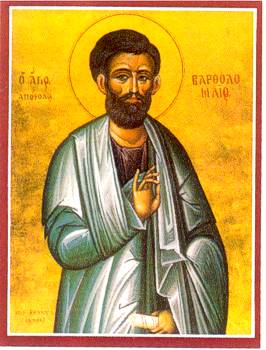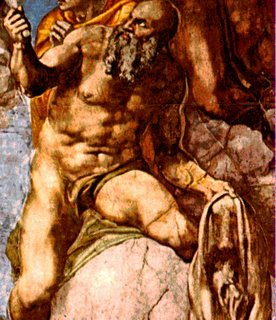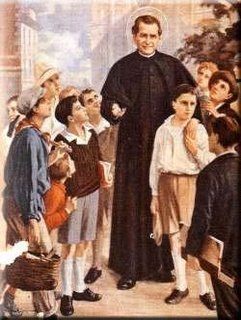Saint John Gabriel Perboyre, also known as Jean-Gabriel Perboyre, was born on January 6, 1802 at Le Puech, near Mongesty, Cahors diocese, southern France. He was the eldest son of Pierre Perboyre and his wife Marie. John’s parents were farmers, and had eight children, five of whom entered the religious life. Three sons became priests in the Congregation of the Mission (Vincentians), and two daughters entered the Daughters of Charity of St. Vincent de Paul.
In 1816, John accompanied a younger brother, Louis, to a high school started by their uncle, Father Jacques Perboyre, C.M. (Congregation of the Mission; Fathers of the Company of Mary; Vincentians; Lazarists), to prepare young men for the seminary. John began to feel a call to the priesthood himself while there, and on June 16, 1817 he made the decision to prepare for the priesthood. Being an obedient son, he had written his parents to tell them of his decision, but told them he would return home to the farm if they objected. They did not, and on December 27, 1818, John entered the Vincentian community.
On December 28, 1820, John took his vows and then went to Paris in January of 1821 to start his study of theology. In October 1823, he was sent to Montdidier, between Paris and Amiens. The Congregation had a boys' boarding school there, and John Gabriel was given charge of a class, with eight boys. In April 1824, he went back to Paris to be ordained sub-deacon, and returned to Montdidier to teach philosophy. In May 1825, he went back to Paris to be ordained deacon. On September 23, 1826, John was ordained a priest in the Rue de Bac by Bishop Louis Dubourg, the former Bishop of New Orleans, on the anniversary of St. Vincent de Paul’s priestly ordination date. In September of 1826 after his ordination, he was appointed professor at the major seminary of Saint Flour, and in September 1827, he was appointed superior at the minor seminary of Saint Flour.
John and his brother Louis exchanged many letters apparently, of which 13 survive today. In one of those, Louis told John that he wanted to go to China after ordination. Louis undertook the voyage to China, but never arrived there, dying at sea on May 2, 1831. John began to seek permission to replace his brother on the mission to China but his Superior General and Council insisted that his health was not good enough. At John’s persistence, they finally asked the doctor, and he gave permission. In February 1835, he wrote to his uncle:
I’ve great news for you. God has just granted me a very precious favor which I certainly don't deserve. When he was pleased to give me a vocation to the priesthood the main reason which made me answer his call was the hope of being able to preach to pagans the good news of salvation. Since then I've never really lost sight of this target, and above all the idea of the Chinese mission always made my heart beat faster.
In March of 1835, John set sail from Le Havre with two confreres, Joseph Gabet and Joseph Perry, arriving at the Portuguese colony of Macao at the end of August. While at Macao, he became ill and while there he studied Chinese.
Just before Christmas, he began the journey to the interior of China, a distance of 600 miles by sea, and another equally great distance by land. He arrived at Ho-nan Province in mid-August of 1836. He wrote several letters upon his arrival there, among them one to his father, the first in over two years:
If we have to suffer martyrdom it would be a great grace given to us by God; it's something to be desired, not feared.
In December of 1836, John preached his first sermon in the Chinese language and then went on his first mission. After he had been in China for over a year he wrote that experienced confreres should be involved in the administration decisions from Macao and Paris, as those who had not experienced the life there, could not understand the problems faced by the missionary.
From September of 1838 until Pentecost of 1839, John gave 17 missions. He was then to go on a round of visits to the mission stations but was replaced by another confrere due to his having leg problems. This meant that John was in Kou-tchen when a band of soldiers arrived in September of 1839. He having breakfast with Giuseppe Rizzolati OFM and Jean-Henri Baldus CM. Rizzolati and Baldus ran off in one direction, John Gabriel in the opposite. John hid in a bamboo “forest“, where he was found the next day after being betrayed by a catechumen.
There are two conflicting stories on John’s being betrayed by the catechumen. One account says that the catechumen met the soldiers, who explained that they were looking for the priest. In that account the catechumen was said to have asked what they would pay for information and they said "thirty taels". However, Baldus in letters he wrote in 1841 after the first account was published, disputes this. Baldus (who was there) said the man who had written the first account was no where near there, contained many errors, and "romantic and, at a minimum, very exaggerated". In a second letter written later by Baldus, he says:
Secondly, the handing over, or betrayal, was brought about not by money but by fear, for Father Perboyre's supposed guide had been beaten up, according to the messengers from Hou-pé.
Initially, during the early time of his imprisonment, John was treated fairly well by orders of the mandarin (former high ranking Chinese official). This changed however under a different mandarin, and John was beaten, hung by his thumbs, made to kneel on iron chains, on pieces of broken crockery, and flogged with bamboo rods. One account says that he was tortured so severely, that his flesh hung in strips.
André Yang C.M., successfully passed himself off as a merchant who was studying the prison system and was able to visit John, bringing him food and hearing his confession. Many of the prison guards assured Yang that John Gabriel would be well treated. However, John suffered his tortures for over a year.
Saint John Gabriel Perboyre was charged with the crimes that he had entered China illegally to preach Christianity "and to deceive and seduce the people". He was found guilty and on September 11, 1840, he was martyred by being strangled on a cross-shaped gibbet, the strangulation being carried out in three stages, and then a kick in the lower abdomen (or side, sources vary) that put an end to his sufferings.
Saint John Gabriel Perboyre was beatified by Pope Leo XIII on November 10, 1889, and he was canonized by Pope John Paul II on June 2, 1996. He is the first saint associated with China. His relics now rest in the chapel of the Vincentian Motherhouse in Paris, France.






![[]](http://saints.sqpn.com/gdi234.gif)














